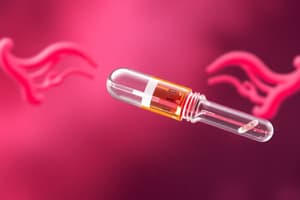Podcast
Questions and Answers
Which of the following are natural estrogens?
Which of the following are natural estrogens?
- Estriol (correct)
- Estrone (correct)
- Mestranol
- Ethinyl Estradiol
What hormone is often used to induce ovulation?
What hormone is often used to induce ovulation?
Clomiphene
Adverse effects of estrogens do NOT include an increased risk of breast cancer.
Adverse effects of estrogens do NOT include an increased risk of breast cancer.
False (B)
The drug ___ is a selective estrogen receptor modulator that is an antagonist on the breast.
The drug ___ is a selective estrogen receptor modulator that is an antagonist on the breast.
Which class of drugs includes Raloxifene?
Which class of drugs includes Raloxifene?
Name one clinical use of progestins.
Name one clinical use of progestins.
What is the main mechanism by which hormonal contraceptives exert their effects?
What is the main mechanism by which hormonal contraceptives exert their effects?
Progestins can cause abnormal lipid and glucose levels.
Progestins can cause abnormal lipid and glucose levels.
What is the role of Mifepristone?
What is the role of Mifepristone?
Flashcards are hidden until you start studying
Study Notes
Gonadal Hormones
- Gonadal hormones include estrogen, progesterone, and testosterone.
- Natural estrogens comprise Estradiol, Estrone, and Estriol.
- Synthetic steroids include Ethinyl Estradiol and Mestranol.
- Non-steroidal synthetics include Diethylstilbestrol and Dienestrol.
Physiological Actions of Estrogens
- Estrogens promote the synthesis of clotting factors II, VII, IX, X, fibrinogen, and anti-thrombin.
- Continuous estrogen exposure may lead to endometrial hyperplasia.
- Estrogens lower LDL and raise HDL cholesterol levels.
- They sensitize myometrium to oxytocin, aiding labor.
- Estrogens decrease bone resorption, impacting bone health.
Indications for Estrogen Use
- Treatment for hypogonadism in girls.
- Administered for hormonal replacement therapy.
- Used in contraception.
- Recommended for osteoporosis management.
- Useful in treating prostate carcinoma.
- Address conditions like Turner's syndrome (gonadal dysgenesis).
Adverse Effects of Estrogens
- Potential for gallstones and pulmonary embolism.
- Increased risks for endometrial and breast cancer associated with long-term use.
- Use of DES during pregnancy may increase vaginal adenocarcinoma risk in daughters.
Selective Estrogen Receptor Modulators (SERMs)
- Clomiphene: Enhances FSH/LH secretion by inhibiting estrogen feedback on hypothalamus/pituitary; used to induce ovulation; risks of multiple pregnancies.
- Tamoxifen: Acts as a partial agonist in certain tissues; used in advanced breast cancer, with endometrial cancer risk due to partial agonism.
- Raloxifene: Agonist for bone and lipid metabolism; antagonist for endometrium and breast; prevents post-menopausal osteoporosis without endometrial cancer risk.
Aromatase Inhibitors
- Anastrozole: Inhibits aromatase, reducing estrogen synthesis; indicated for post-menopausal breast cancer resistant to tamoxifen.
Progestins
- Synthetic analogs of progesterone are categorized by generation based on structure and potency.
- First generation: Norethindrone, Ethynodiol diacetate.
- Second generation: Levonorgestrel, Norgestrel.
- Third generation: Desogestrel, Norgestimate.
- Fourth generation: Drospirenone.
Clinical Uses of Progestins
- Administered for hormonal replacement therapy and contraception.
Adverse Effects of Progestins
- Possible effects include breakthrough bleeding, hirsutism, and acne (androgenic side effects).
- Alterations in lipid and glucose metabolism may occur.
Antiprogestins
- Mifepristone: Acts as a progesterone receptor antagonist and glucocorticoid receptor antagonist; effective in post-coital pregnancy prevention and early pregnancy termination.
Hormonal Contraceptives
- Two main types:
- Combination of estrogen and progestin: Inhibits gonadotropin release, especially LH surge during midcycle.
- Progestin-only options are also available.
Studying That Suits You
Use AI to generate personalized quizzes and flashcards to suit your learning preferences.




